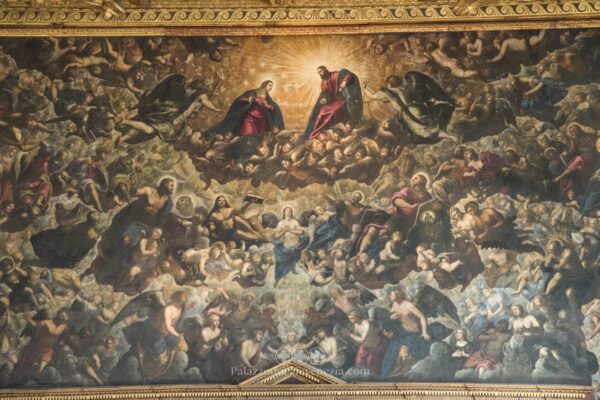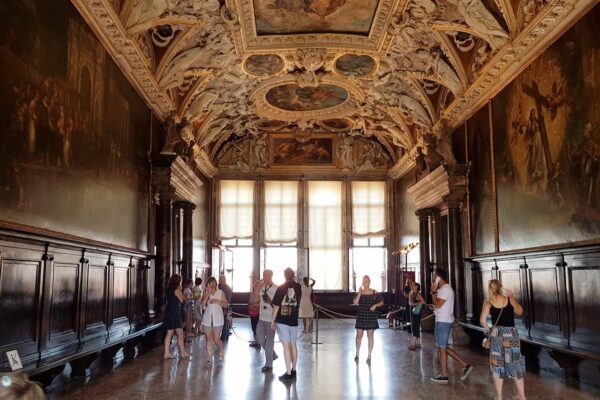Are you about to visit the interior of the Doge’s Palace in Venice? In this article I will list the numerous rooms of the Palace and the functions they performed, with a summary of the main works housed inside.
In this article, for the sake of ease of understanding the structure of the building even for those who are not currently inside it, I will follow a division by floors and not by tour route (for which I have prepared a separate article).
Are you ready? Let’s start the visit!
Before we begin, a brief preamble: if you plan to visit the Doge’s Palace in Venice, the halls and all the other rooms, it is strongly recommended that you buy your ticket online, because of the long queue that may form at the ticket office. By purchasing your ticket in advance, you will be able to enter the Doge’s Palace skipping the queue.
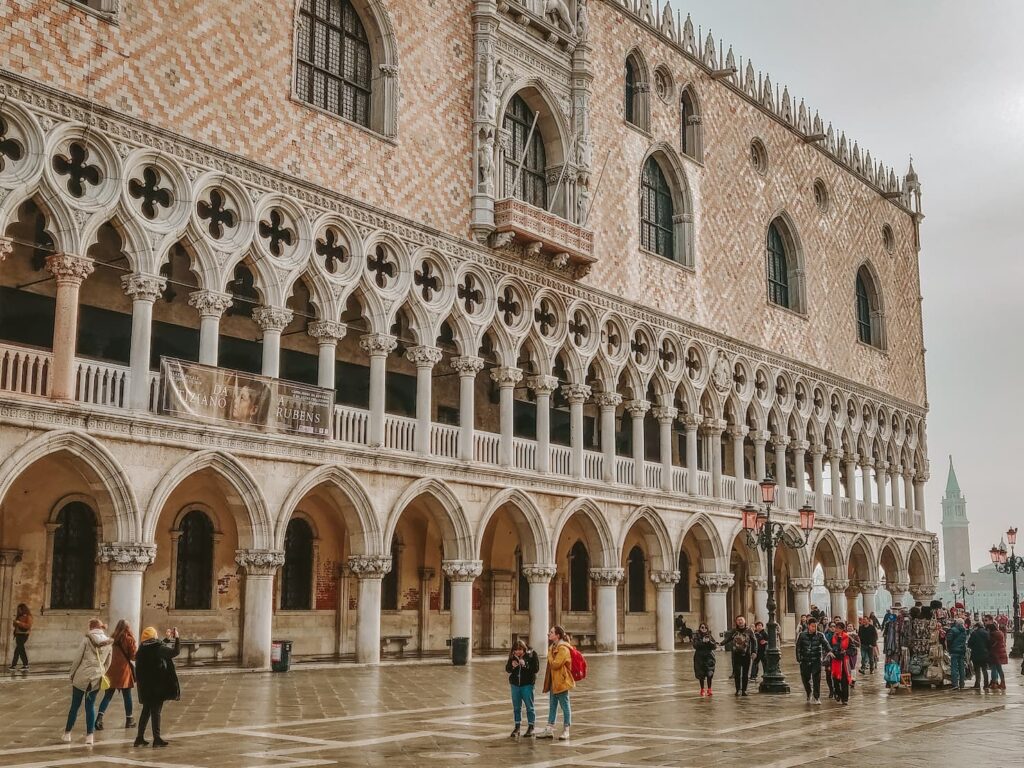
Doge’s Palace Venice skip-the-line ticket: quick access
Buy online. Choose your preferred time. Visit Venice’s Doge’s Palace, Bridge of Sighs, prisons and more.
You can cancel for free up to the day before your visit.
Table of content
- 1 Structure of the Palace
- 2 The Ground Floor
- 3 The First (noble) Floor
- 4 The Second (noble) Floor
- 4.1 The Doge’s flat
- 4.2 Scarlatti Hall
- 4.3 Shield Room
- 4.4 Grimani Hall
- 4.5 Erizzo Room
- 4.6 Hall of the Stuccoes or Priuli
- 4.7 Hall of the Philosophers
- 4.8 Corner Hall
- 4.9 Hall of Portraits
- 4.10 Hall of the Squires
- 4.11 Liagò
- 4.12 Quarantia Civil Vecchia
- 4.13 Armamento Room (or Sala del Guariento)
- 4.14 Hall of the Scrutiny
- 4.15 The Hall of the Great Council
- 5 The third (noble) floor
- 6 The Attic
- 7 Interior of the Doge’s Palace Venice: frequently asked questions
- 8 Conclusions
Structure of the Palace
The Palace has a complex structure divided into several floors:
- The Ground Floor is occupied by the Opera Museum and the Palace’s former prisons, called ‘Wells’;
- The First Floor is occupied by the loggias, the offices of the Museum and the Superintendence and some rooms connected to the prisons used for the trial of crimes;
- The Second Floor is largely occupied by the Doge’s flats, as well as the rooms of the Great Council and the Scrutiny;
- The Third Floor houses the seats of the major organs of government of the Republic and the Palace armoury;
- The attic houses the prisons called ‘Piombi’ and the Chancellery.
The Ground Floor
The Opera Museum
At the time of the Venetian Republic, the maintenance of the Doge’s Palace was the responsibility of the Senate, which was sometimes assisted by commissions formed ad hoc, and of the proto, i.e., the architect at the service of the Provveditori del Sale, the magistracy that administered the funds destined for the repair of public works.
The Opera of the Doge’s Palace was founded in the 19th century and carries out the functions of protection of the monument following the fall of the Venetian Republic. The Museum inside contains a layout divided into six rooms on the ground floor, formerly used as prisons.Room I displays the famous capitals, with their columns, from the portico of the palace facade. The room also houses the wooden model of the shoring made to support the building during the 19th century restoration.
The Prisons (Wells)
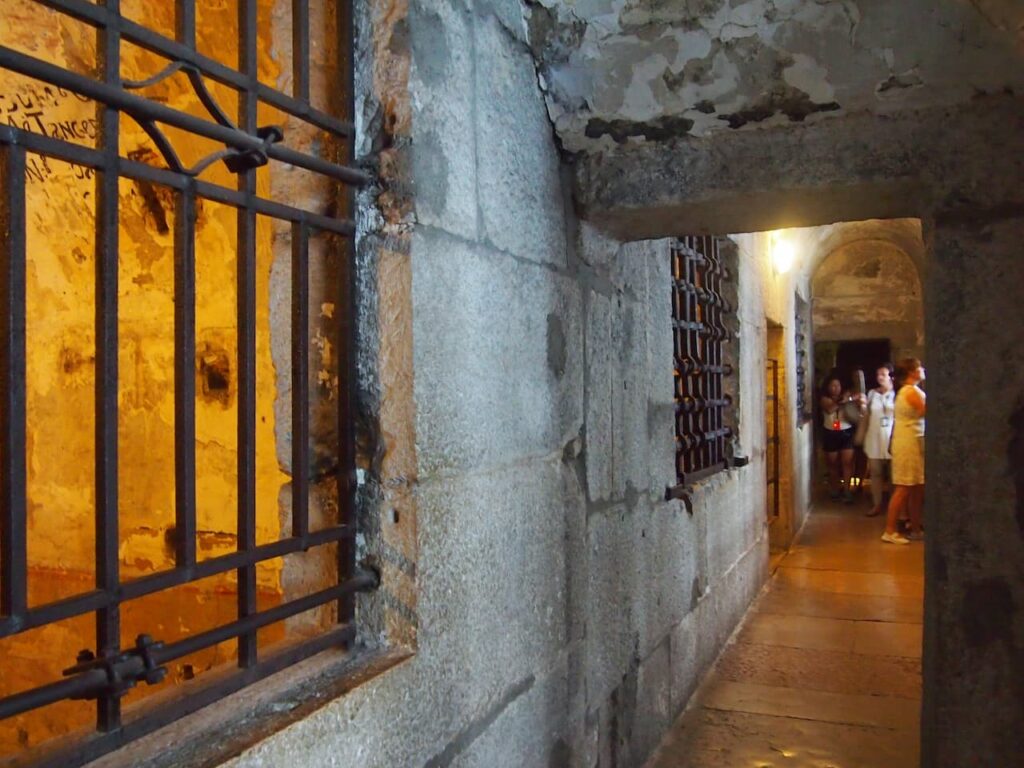
The Prisons occupied all the floors of the Palace. On the ground floor there were very small cells with ceilings so low that they did not allow standing, the famous ‘Pozzi’ (Wells). Each cell contained a single board as a bed, a shelf, and a receptacle for bodily needs.
These were the cells intended for inmates who had committed the most serious crimes and were unlikely to regain their freedom.
Access to these unhealthy places of detention was via a staircase at the height of the Giants’ Staircase, after which internal stairs connected all four levels of the prisons from the ground floor to the attic.
The First (noble) Floor
The first floor of the Palace is surrounded towards the courtyard by a loggia with ogival arches that continues outside, overlooking the basin and the small square.
The large complex of loggias accessed via the Giants’ Staircase allows to tour along the three wings of the Palace, with suggestive views of the courtyard and Piazzetta San Marco.
The rooms overlooking the loggia are only partly included in the tour: the 14th-century wing houses the offices of the Soprintendenza per i Beni Architettonici e Paesaggistici di Venezia e Laguna (Venice and Lagoon Architectural and Landscape Heritage Office), the Renaissance wing houses the management and offices of the Fondazione dei Musei Civici di Venezia (Venice Civic Museums Foundation); in the next room, once occupied by the Lower Chancellery, is the Bookshop.
At one time the main access to the palace was via the Giants’ Staircase; today the visitor route starts from the Censors’ Staircase.
The Golden Staircase
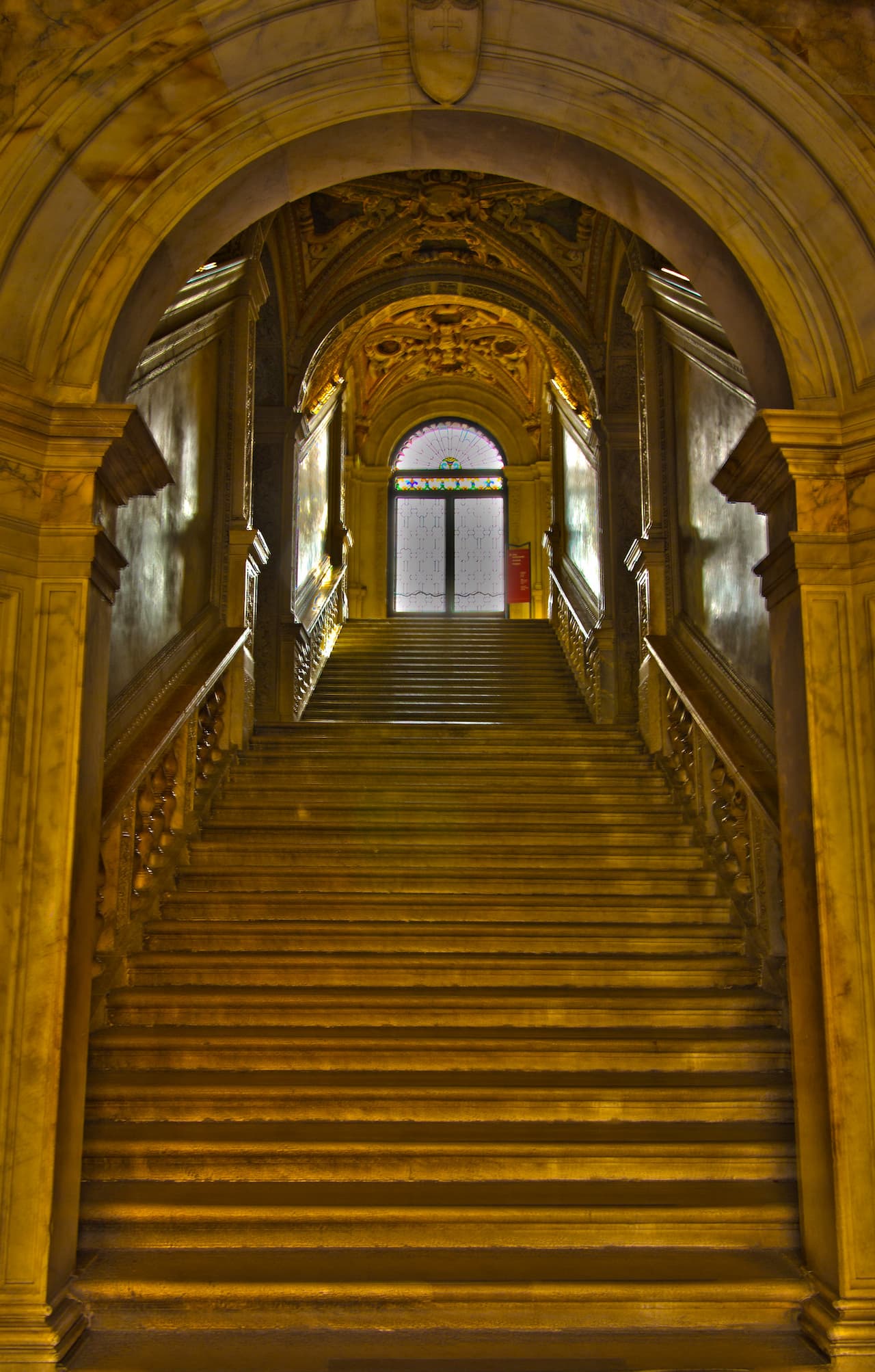
Access to the doge’s flats and the institutional rooms is via the majestic Golden Staircase, so called because of the bright stuccoes embellished with gold leaf.
The vault of the staircase is decorated with frescoed panels and at its foot are two columns supporting the 16th-century statues of Hercules slaying the Hydra and Atlas carrying the celestial vault, by Tiziano Aspetti.
The decoration of the vault, which was completed in the second half of the 16th century, depicts subjects dedicated to the goddess Venus, a native of Cyprus, an island subjugated by the Venetian Republic, and to the god Neptune, king of the seas and the Virtues necessary for good government.
The stuccoes are the work of Alessandro Vittoria, while the frescoed inserts with grotesques and scenarios of greater complexity are the work of mannerist painter Battista Franco.
The Second (noble) Floor
The Doge’s flat
Taking the Golden Staircase to the first landing and the first side ramp on the right, one enters a wide corridor leading to the doge’s flat.
The doge’s flats have always been in this wing of the palace, close to St. Mark’s apse.
Destroyed after a fire in 1483, they were renovated by architects Antonio Rizzo and Pietro Lombardo. The decoration of the rooms is limited exclusively to ceilings, friezes, and fireplaces, this because each doge, as soon as he was elected, moved in with his personal furnishings. Although the flats housed the highest office in the state, they contained few spaces for his private life.
Scarlatti Hall
This room served as an antechamber for the ducal councilors, the name referring to the purple togas these officials wore.
The wooden ceiling dates to the 16th century and is the work of Pietro and Biagio da Faenza, while the fireplace bearing the coat of arms of Doge Agostino Barbanigo is the work of the Lombardo workshop. Above the doors are stone bas-reliefs depicting a Madonna and Child and a Madonna adored by Doge Leonardo Loredan.
In the room you can also admire two fresco lunettes, one is Titian’s Madonna and Child, the second depicts The Resurrection, and is the work of Giuseppe Porta.
The small wooden altarpiece represents Doge Loredan with St. Mark in Adoration of the Virgin and St. John the Baptist and is by Vincenzo Catena.
Shield Room
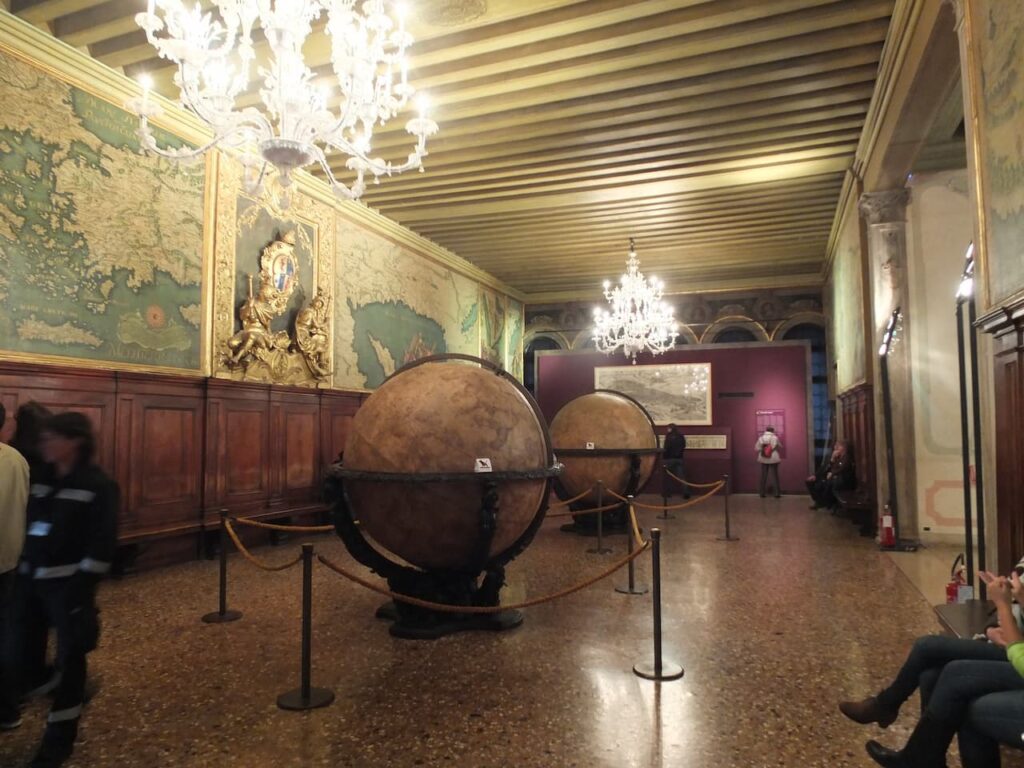
The Hall of the Shield is characterized by the presence of two large 18th century globes depicting the celestial sphere and the terrestrial sphere. The room runs the entire length of the palace, from the canal to the courtyard.
The room served as a place of representation for receptions and official meetings and housed the ‘shield’, i.e., the coat of arms of the reigning doge. Today, that of the last doge of the Serenissima, Ludovico Manin (1789-1797), is still preserved. The maps were originally made by the geographer and humanist Giovanni Battista Ramusio, the Greek Giovanni Domenico Zorzi and the Piedmontese Giacomo Gastaldi, and were completely renewed in 1762 at the behest of Doge Marco Foscarini.
The maps depict the countries of each continent, the Mediterranean states, Scandinavia, and the islands close to the Ice Sea, the regions of North America, the lands bordering the South Atlantic, China, India and Asia Minor. The travels of famous Venetian explorers are also celebrated, including Marco Polo, Giovanni and Sebastiano Caboto, Nicolò Zen (arrived in Greenland in 1380), Pietro Querini (shipwrecked in Norway in 1432) and Alvise da Mostro (discoverer of Cape Verde).
Grimani Hall
A room used for the Doge’s audiences, which always housed the portrait of the dux in office.
The room was decorated under the principality of Marino Grimani (1595-1605), who commissioned the gilded carved ceiling, on which his coat of arms is featured, and the frieze with allegorical figures painted by Giulio dal Moro.
The fireplace is adorned with a bas-relief depicting sea deities surrounding the lion of St. Mark.
The canvases on the walls feature several representations of the Lion of St. Mark, including Vittore Carpaccio‘s famous Lion Andante dated 1516, which shows a view of the Doge’s Palace with the adjacent Piazzetta in the background. The Lion, with its hind legs resting on the waves of the sea, symbolizes the dominion of Venice over land and sea.
Erizzo Room
This room also features a ceiling with gilded carvings on a blue background and a fireplace of the Lombard school.
The fireplace is surmounted by a mantle with stucco figures of Venus and Vulcan, dating back to the Doge’s Office of Francesco Erizzo, who was also a valiant military man, whose exploits are depicted on the frieze paintings by Giovanni Battista Lorenzetti.
The other paintings in the room by Girolamo Bassano depict sacred subjects, The Ascent to Calvary, Noah’s Ark, and the Presentation in the Temple.
The roof garden overlooking the palace courtyard was reached by a movable ladder next to the window.
Hall of the Stuccoes or Priuli
The small room is decorated on the vaults and fireplace with stucco work by the late Mannerist artist Giulio dal Moro executed under the Doges Marino Grimani (1595 – 1605) and Antonio Priuli (1618 – 1623).
On the walls are nine paintings from the Prucuratia ‘de supra’. Next to sacred scenes by Bonifacio de’ Pitati, Pordenone, Salviati and Bassano’s workshop, there is a painting by Jacopo Tintoretto, the Portrait of Henry III, who was received in Venice with great festivities during his return journey from Poland to France to ascend the throne after the death of Charles IX.
Hall of the Philosophers
This room was decorated at the behest of Doge Marco Foscarini, who had images of ancient philosophers, painted in the second half of the 16th century by Paolo Veronese and other masters for the library of the Biblioteca Marciana, placed within twelve stucco frames. The canvases returned to their original location in 1929 and were replaced by portraits and allegorical figures dated to the 17th century.
On the wall facing the courtyard is a small doorway, from which an internal staircase led to the Doge’s room on the upper floor. Just above the opening, after walking down the first few steps, you can admire the St. Christopher with the Child on his shoulders painted by Titian in 1523-24.
Corner Hall
This room houses a late 15th-century marble fireplace with a frieze depicting winged putti on dolphins, and in the centre the Lion of St. Mark.
At the top of the walls is a painted band with representations of the twelve months.
In addition to the family tree of the Foscarini family and a 17th-century depiction of the Battle at the Bridge of Fists in San Barnaba, there are two paintings by Filippo Zamberti on the dogate of Giovanni I Corner with a solemn banquet and a visit to the island of San Giorgio.
Hall of Portraits
This small room houses a fireplace from the Lombardo workshop executed at the time of Doge Agostino Barbanigo. In addition to the Madonna Enthroned with Child by Alvise Vivarini and The Praying Virgin of the Giotto school, you can admire here the famous Lamentation of Christ by Giovanni Bellini from the Palace chapel.
Hall of the Squires
This room was once the entrance to the doge’s flats, and still retains part of the original decoration on the ceiling and in the sumptuous portal leading to the Hall of the Shield, surmounted by an allegorical group with the coat of arms of Doge Marcantonio Memmo (1612-1615).
The squires, from whom the room takes its name, were appointed for life by the doge and oversaw the antechamber services, accompanying the prince on processions and parades, with the task of carrying the symbols of his dignity.
Liagò
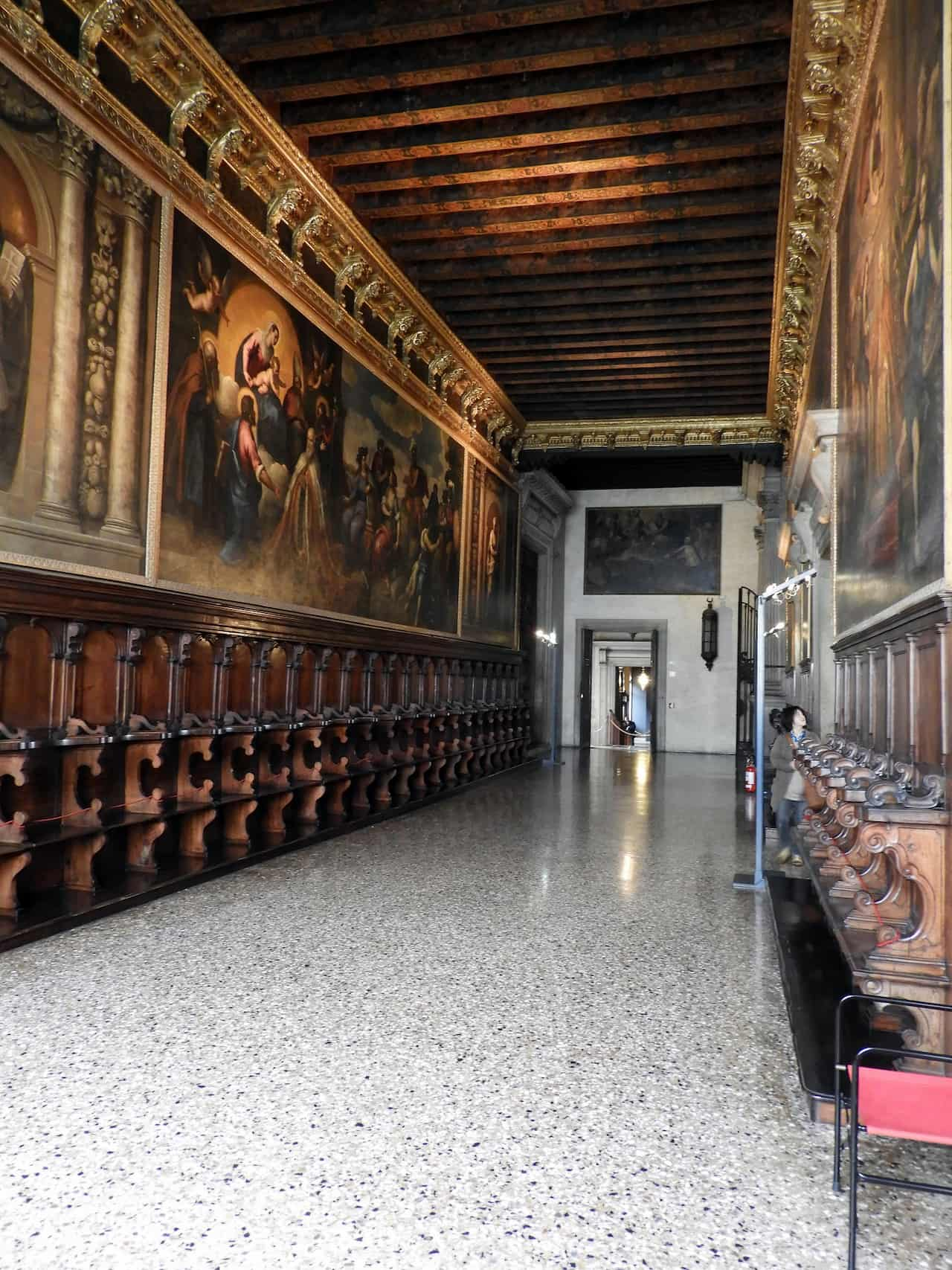
This room served as an antechamber to the Great Council Chamber.
The gilded beamed ceiling dates to the 16th century, while the canvases date from the following century, with works by Domenico Tintoretto (The Seafarer offers a model of a galley to Santa Giustina, The Transfiguration, Doge Giovanni Bembo before Venice with allegorical figures) and Jacopo Palma the Younger (Doge Marcantonio Memmo before the Virgin with symbolic figures of subject cities, Religion, Concord).
In the adjoining vestibule is the preparatory cartoon for one of the mosaics of the second external portal of St. Mark’s Basilica by Sebastiano Ricci with The Arrival in Venice of the Body of St. Mark and three sculptures by Antonio Rizzo, Adam and Eve and The Shield Bearer, made to decorate the Foscari Arch.
Quarantia Civil Vecchia
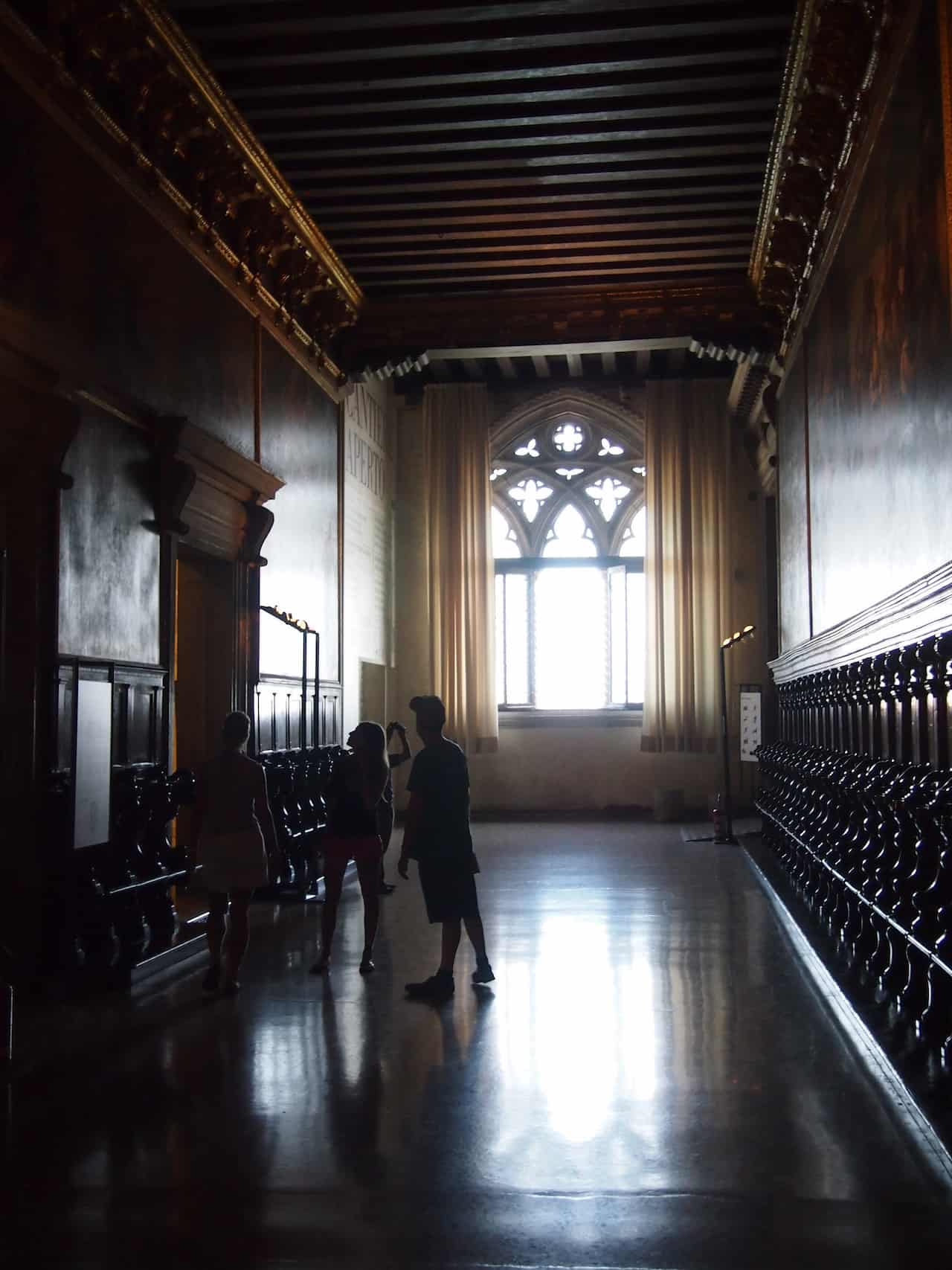
This room housed the Magistracy of the Council of Forty, responsible for judicial matters. In the 15th century, the Council was divided into three assemblies:
- The Criminal Quarantia for criminal offences
- The Quarantia Civil Vecchia for lawsuits and appeals from the city Venice
- The Quarantia Civil Nuova for mainland cases and appeals
The space, which took on its original conformation in the 17th century, is dominated by the large Gothic window on the side of the canal, and preserves behind the wooden dossals on the perimeter, traces of a fresco from the previous decoration.
The 17th-century canvases depict themes related to the celebration of Venice.
Armamento Room (or Sala del Guariento)
This small room was used as an ammunition depot, as well as a resting place for the armed corps that supervised the sessions of the Great Council.
It houses the great 14th-century fresco by Guariento, which was found under Tintoretto’s painting of Paradise, and then detached and relocated in 1903. The work represents the Coronation of the Virgin seated on a throne next to the Redeemer.
Hall of the Scrutiny
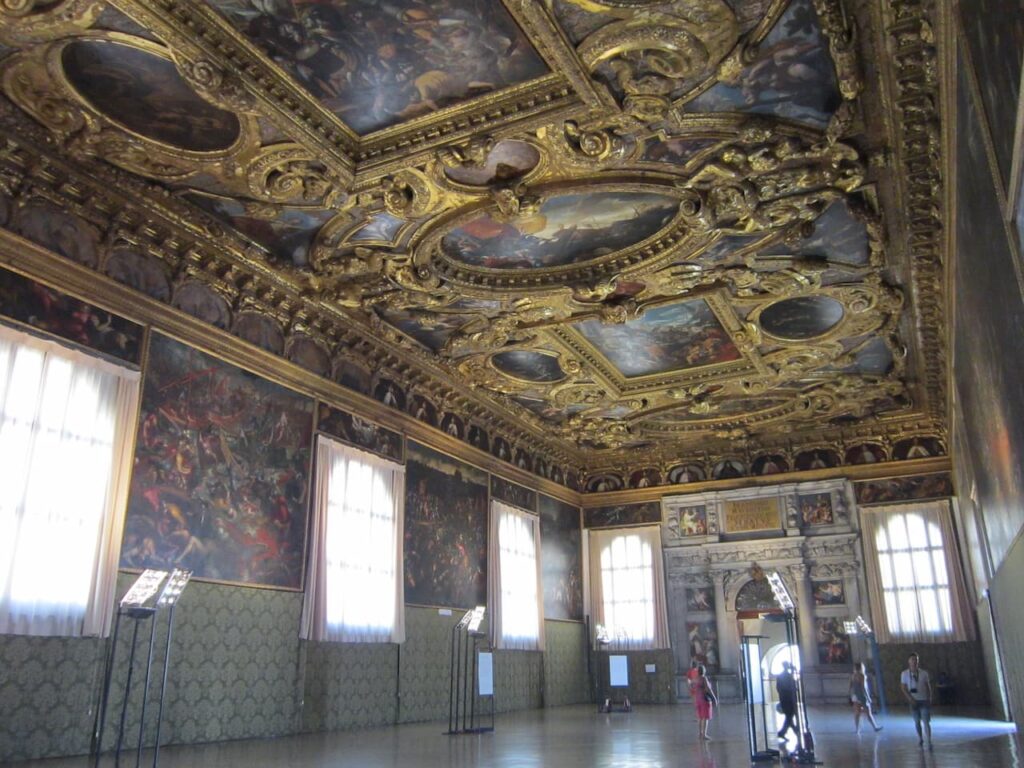
Through a passageway or the nearby room where the Quarantia Civil Nuova used to meet, one reaches the room used for voting procedures. Before being used for this task, this space housed the precious codices that Francesco Petrarch and Cardinal Bressanone had donated to the Venetian Republic, later transferred to the Biblioteca Marciana.
The original works in the room were destroyed by fire in 1577. The new design was prepared by Cristoforo Forte. The canvases on the walls depict glorious deeds of Venetian citizens.
Worthy of note is the painting of The Last Judgement by Jacopo da Palma Il Giovane (1594 – 1595).
The Hall of the Great Council
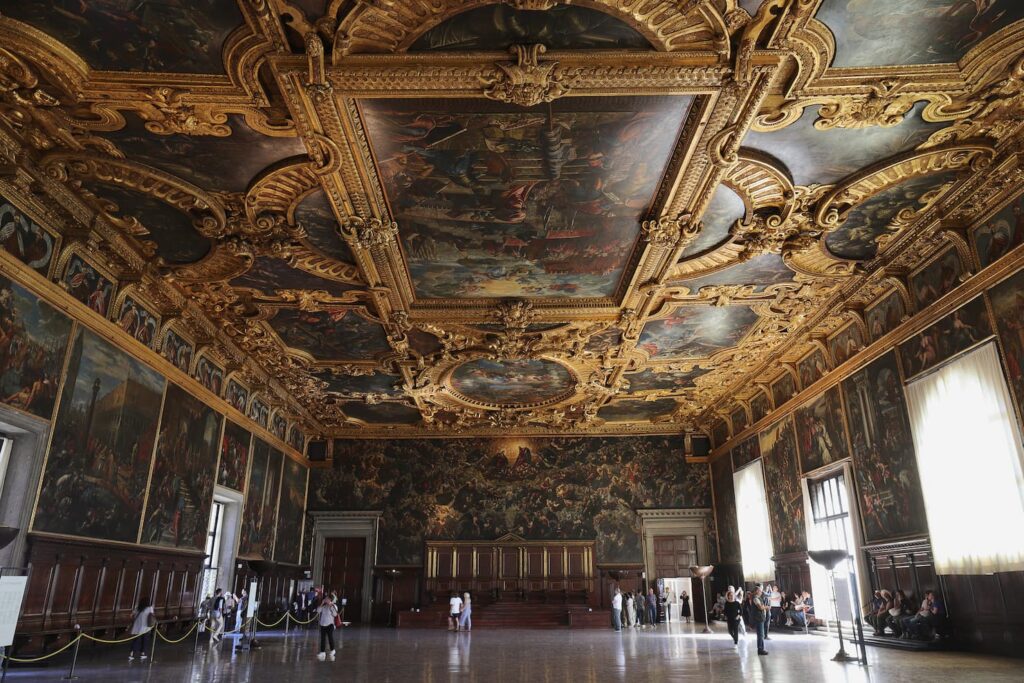
The wing of the Doge’s Palace facing St. Mark’s Basin is occupied almost entirely by the Hall of the Great Council, the room that hosted the sessions of the plenary council of the Republic.
The doge sat in the centre of the court together with his councillors, surrounded by the three heads of the Council of Ten and the Quarantia Criminale, the avogadori di Comun and the censors, while the patricians sat on the side benches around the perimeter of the room and on the double benches placed side by side in nine rows.
The hall is enormous in size, 53 meters long by 25 meters wide, could hold more than 2,000 people and occupies almost the entire wing of the palace facing St Mark’s Basin.
The wooden ceiling is completely covered with gold and painted canvases, its structure is composed of a system of beams and trusses that allow the heavy ceiling to hold up without the aid of columns.
On the walls are large canvases depicting episodes from Venetian history such as The Fourth Crusade of 1202, on the side facing the basin, and The Peace of Venice, the theme being the city’s relations with the papacy and the Holy Roman Empire.
The canvases decorating the roof of the room depict the deeds and virtues of valiant Venetian citizens, while in the centre is an allegorical glorification of the Republic by Veronese, the ‘Triumph of Venice, Crowned by Victory’, placed on the wall of the tribunal. The work depicts Venice crowned and surrounded by Honour, Peace and Happiness in the presence of the entire Venetian society, from the nobility to the people, guarded by mounted guards.
Towards the courtyard are paintings of twelve episodes concerning the events of Alexander III and Frederick Barbarossa.
Beneath the ceiling is a frieze by Tintoretto with portraits of the first seventy-six doges of Venice (from the year 804 to 1556), each doge holding a scroll depicting the most significant works of his dogate.
At the end of the room is the colossal painting of Paradise painted between 1588 and 1592 by Jacopo Tintoretto.
The painting has Jesus and Mary as the central protagonists, a light descends below them, the holy spirit falling exactly on the tympanum of the throne on which the doge sat.
The theme is not only religious but also the Allegory of Good Government, the light is the divine essence that enters the figure of the doge and allows him to always make the right decision.
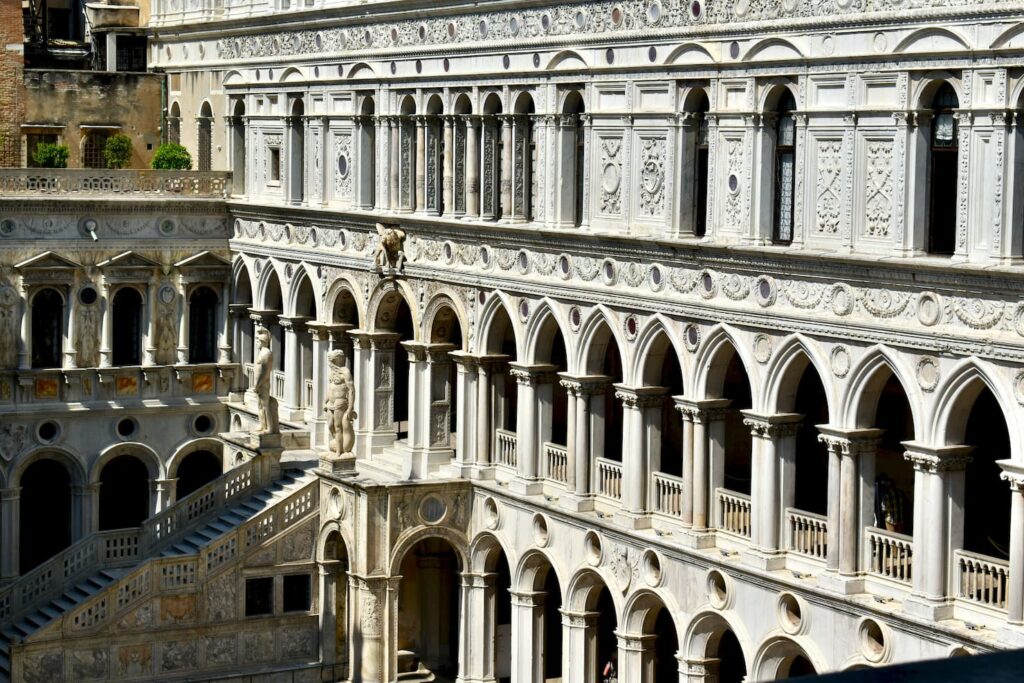
Doge’s Palace Venice skip-the-line ticket: quick access
Buy online. Choose your preferred time. Visit Venice’s Doge’s Palace, Bridge of Sighs, prisons and more.
You can cancel for free up to the day before your visit.
The third (noble) floor
Once through the doors of the true portal, the Golden Staircase, the tour continues to the institutional rooms on the upper floor.
The second floor of the Palace is occupied by a series of sumptuous rooms, decorated from 1574 onwards, the year in which a fire caused damage to this area of the building.
Square atrium
Take the last flight of the Golden Staircase to reach the square atrium. This room leads to the halls that housed the most important meetings in the political life of the Venetian Republic.
In the center of the ceiling is immortalized Doge Girolamo Priuli (1559-1567), together with the eponymous saint and the personifications of Peace and Justice, depicted within the octagonal canvas painted by Tintoretto. Also by Tintoretto’s workshop are the eight side paintings with biblical episodes and putti symbolizing the seasons.
Currently on display in the room are sacred scenes painted in the late 16th century, The Announcement to the Shepherds by Girolamo Bassano and three canvases attributed to Veronese, Adam and Eve Expelled from Paradise, The Prayer in the Garden and St. John Writing the Apocalypse.
Hall of the Four Doors
This solemn hall occupies the entire width of the floor, from the courtyard to the canal. It functioned as a place of high representation, awaiting the entrance to the councils, and as a link between the halls where the highest magistracies of the Republic met.
The hall was restored following a fire in 1574 based on a design by Andrea Palladio and Giovanni Antonio Rusconi. The barrel-vaulted ceiling is adorned with gold and stucco work largely executed by Giovanni Battista Cambi, known as Bombarda. The iconographic program on it was designed by the polygraph Francesco Sansovino. On the vault are painted grotesques with allegorical figures, deities, putti, winged genii, sirens, and tritons. The strong symbolic charge is emphasized by the fresco representations by Jacopo Tintoretto, of which very little remains, however, due to restoration work made necessary by the problems of time and humidity.
The oval canvases include personifications of Venice and cities subjected to it (Verona, Brescia, Istria, Padua, Friuli, Treviso, Vicenza, Altino), while the larger sections depict Jupiter handing over dominion of the Adriatic to Venice, Juno offering Venice the insignia of power and Venice breaking the yoke of slavery.
Dating back to 1758 is the canvas Neptune offers gifts to Venice by Giambatttista Tiepolo, while the canvas depicting Venice leaning against the world is by Nicolò Bambini.
Each of the four doors, designed by Andrea Palladio, have a corresponding sculptural group evoking the tasks of the governing bodies of the halls to which they led:
- Vigilance, Eloquence, The Ease of Audience for the College
- Peace, Pallas, War for the Senate
- Authority, Religion, Justice for the Council of Ten
- Secrecy, Diligence, Fidelity for the Chancellery.
The decoration on the walls includes votive scenes and re-enactments of historical events.
Antichamber of College
This room was the antechamber of honor where foreign delegations and ambassadors waiting to be received by the Serenissima Signoria stayed, as well as Venetian magistrates returning from their duties.
This room was also damaged in the fire of 1574 and was renovated to a design by Palladio and Vincenzo Scamozzi. The monumental fireplace with the two marble telamons houses on its upper base a relief with Venus asking Vulcan for weapons for Aeneas. The same technique is adopted for the plastic decoration of the walls and ceiling, executed in 1576-77 by Marco d’Agnolo.
In the center of the ceiling is an octagon with a fresco by Paolo Veronese depicting Venice dispensing riches and honors.
On the walls are four canvases of mythological subjects by Jacopo Tintoretto, originally made for the square atrium, Mercury and the Graces, Pallas Banishes Mars, Arianna Found by Bacchus and The Forge of Vulcan. These allegories of the seasons can be interpreted to signify the wise and prudent government of the Republic.
The tympanum of the portal leading to the Sala del Collegio is surmounted by three sculptures by Alessandro Vittoria: the personifications of Venice, Concordia, and Glory.
College Hall
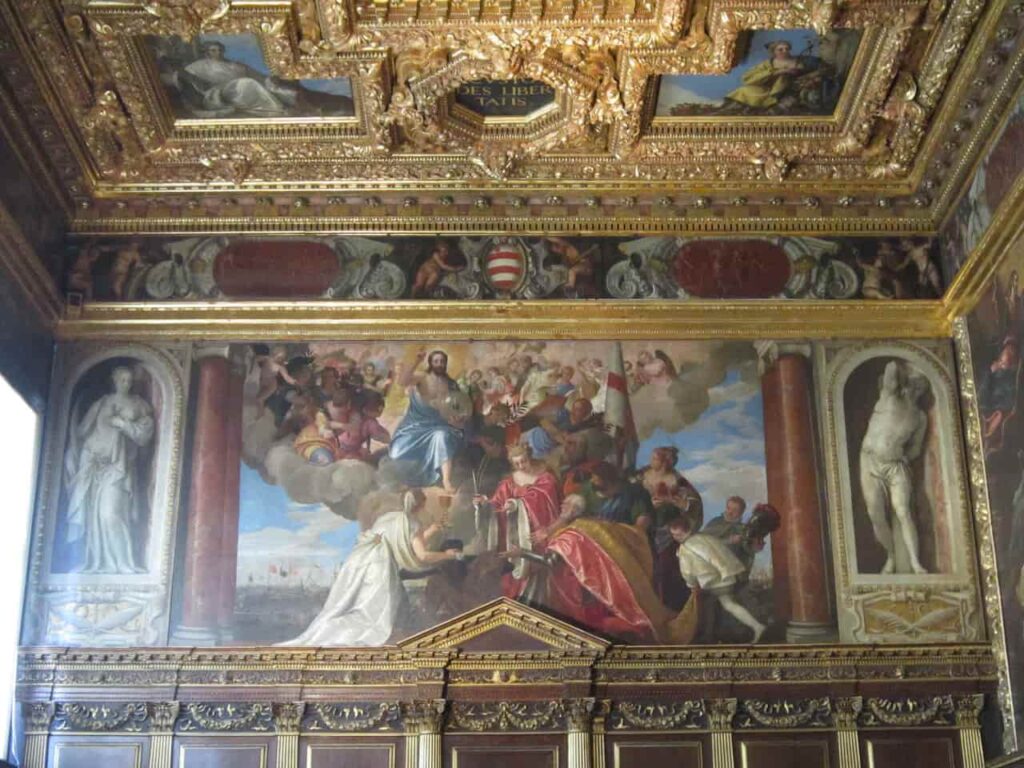
This room was the seat of government of the Pien Collegio, a state body composed of the Signoria (i.e., the Doge, the Minor Consiglio, and the three heads of the Quarantia Criminal) and the Savi. The college discussed matters of political, economic, military, and foreign affairs to be brought before the Senate and received diplomats.
The wooden seats were made after a fire in 1574, as were the ceiling carvings by Andrea Faenza and Francesco Bello.
In the frames are paintings by Paolo Veronese depicting subjects of ancient history and the Virtues necessary for Good Government. Also by Veronese is the canvas above the tribunal depicting The Battle of Lepanto against the Turks.
The votive paintings depicting the doges with the Virgin Mary and St. Catherine are instead by Jacopo and Domenico Tintoretto. Finally, the late 16th century fireplace with Hercules and Mercury and the wall clock that marked time during the sessions of the Collegio are worth mentioning.
Senate Hall
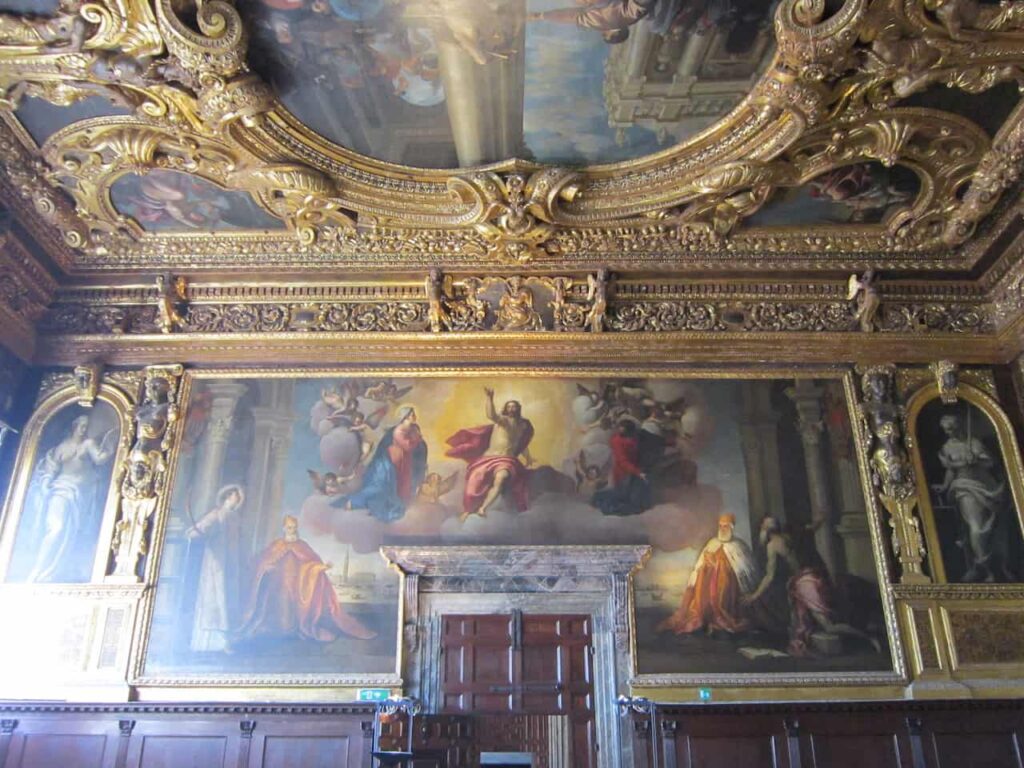
The Senate, also called the Council of Patricians, was a body composed of sixty patricians and a commission of patricians of equal number, called ‘zonta’.
During the meetings the Senate was joined by the Minor Council, the Quarantie, the Avogadori di Comun, the Council of Ten, the Saviors and if necessary other magistrates, a total of up to two hundred members.
This hall was also restored by Antonio da Ponte after the fire. It has a wooden ceiling with the painting The Triumph of Venice by Domenico Tintoretto in the center, surrounded by works depicting the virtues of the Republic of various autographs.
The walls of the courtroom are adorned with two clocks, one of which bears the signs of the zodiac, allegorical scenes, and votive paintings from the late 16th century.
Above the tribunal is Dead Christ supported by angels adored by Doges Pietro Lando and Marcantonio Trevisan by Jacopo Tintoretto and workshop, facing Doges Lorenzo and Girolamo Priuli in Adoration of Christ Triumphant by Palma il Giovane.
The other canvases in the room are by Tintoretto, Palma il Giovane, Tiepolo and Marco Vecellio.
Hall of the Council of Ten
This room housed the committee of the Ten, the Minor Consiglio and at least one avogadore del Comun. Meetings of the utmost secrecy were held here on delicate matters such as the tranquility and prosperity of the state, public order, the punishment of political offences or those committed by the nobility, and the morals and good manners of citizens.
To achieve their aims, the commission could also make use of torture.
On the perimeter of the room are the wooden bumps on which the council members sat, although those on the semicircular tribune are missing. A door led to the offices behind and, via the stairs, to the prisons.
The walls are decorated with a frieze by Giambattista Zelotti with putti, allegorical figures and the coat of arms of Doge Francesco Donà, and canvases from the late 16th and early 17th century including The Adoration of the Magi by Antonio Aliense, and The Peace of Bologna between Charles V and Clement VII in 1530 by Marco Vecellio.
Of particular interest is the pictorial decoration enclosed in the carved festoons of the ceiling, the work of Giambattista Ponchino da Castelfranco and Paolo Veronese, bearing a series of chiaroscuro paintings with allegorical and symbolic subjects that surround the larger panels with deities and representations of the greatness of the Republic.
Hall of the Compass
This room takes its name from the large corner compass, which provides access to two hidden passages, surmounted by a statue of Justice. From here witnesses, defenders and accused could access the rooms where the trials of the supreme court of the Republic, the Council of Ten and the halls of the Three Chiefs of the Inquisitors took place.
The places where the organs of the magistracies sat were connected to the old prisons by ladders, which ascended from the wells to the Piombi.
The canvas in the centre of the ceiling depicts St. Mark crowning the togal virtues, a 19th century copy of the original by Paolo Veronese, now on display in the Louvre after being stolen by the French in 1797.
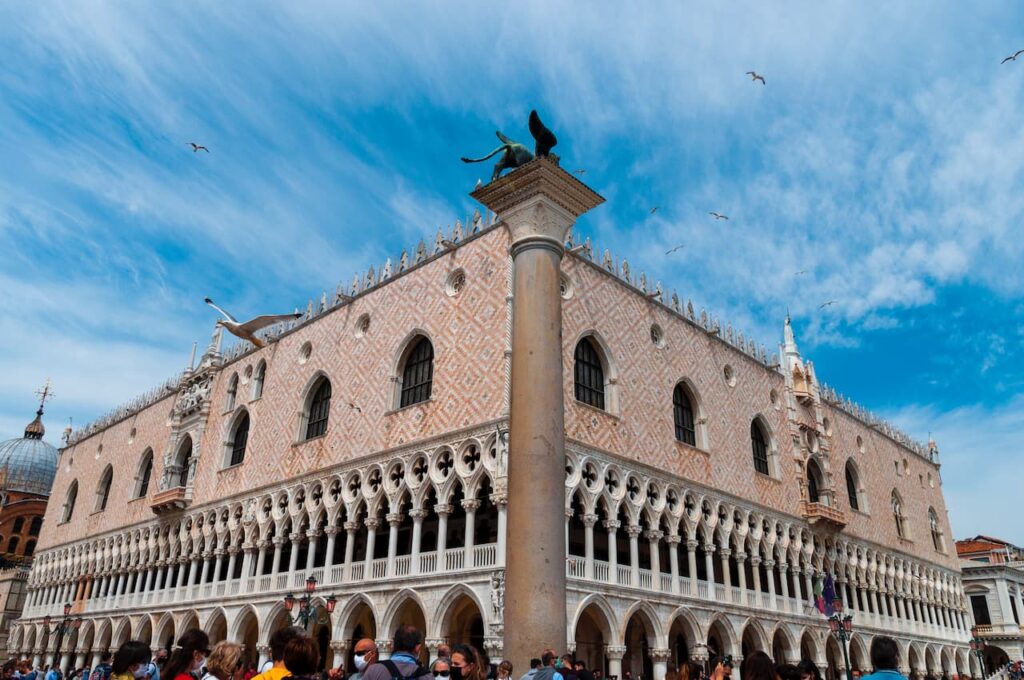
Doge’s Palace Venice skip-the-line ticket: quick access
Buy online. Choose your preferred time. Visit Venice’s Doge’s Palace, Bridge of Sighs, prisons and more.
You can cancel for free up to the day before your visit.
The Armory
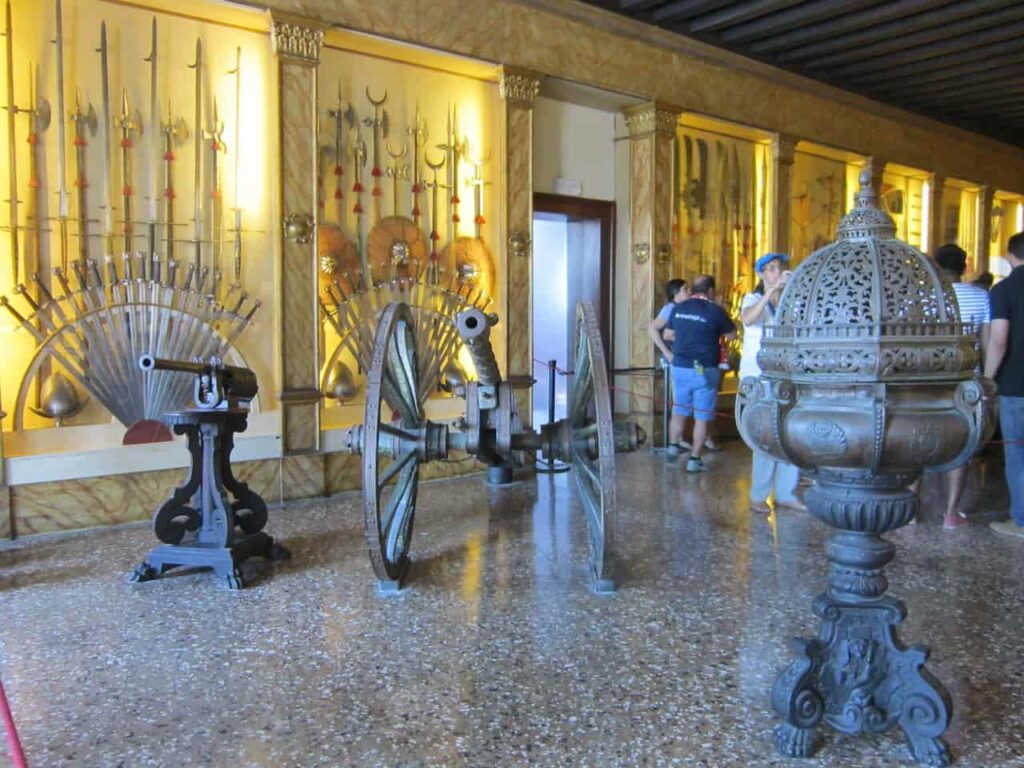
Weapons were kept in this repository, first placed under the control of the Great Council.
The initials ‘CX’ on the entrance lock and on many pieces indicate that they belonged to the Council of Ten, which was later entrusted with the management of these spaces.
Inside the armory are shields and turquoises, as well as other kinds of memorabilia, including war booty, trophies, banners, fabrics, sculptures, and paintings donated to the State, which made the armory also take on the function of representation, so much so that it was exceptionally opened when Henry III visited Venice.
The collection consists of over two thousand weapons, of different forms and methods of use, and is divided into four rooms.
The Attic
The Prisons (Piombi)
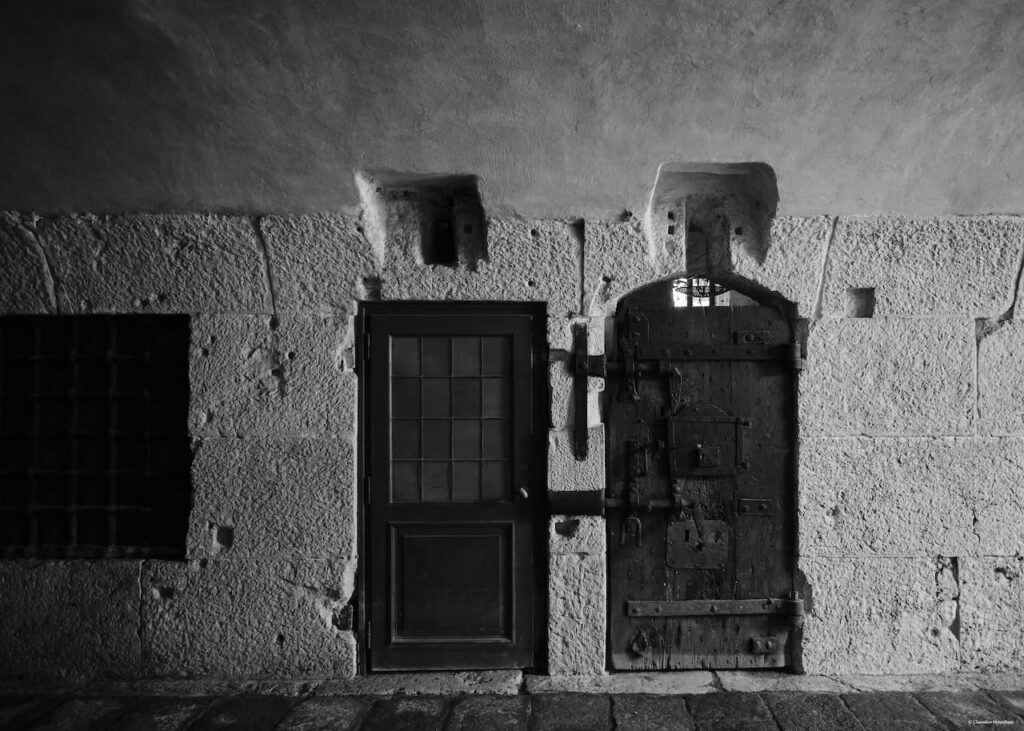
The attic is occupied by the top floor of the prisons, known as ‘Piombi’. The name derives from the metal of the roofing sheets, which caused the temperature to reach extremes during the summer.
These cells were intended for special prisoners awaiting trial or of wealthy origins.
On the same floor is the Torture Room, where confessions were extracted from the accused.
Superior Chancery
The walls of this room are entirely covered with wooden cabinets dating back to the 18th century, with painted coats of arms and the names of the chancellors. Inside were kept the archives of the Signoria and Collegio, as well as the registers of the laws of the Great Council and the deliberations of the Senate.
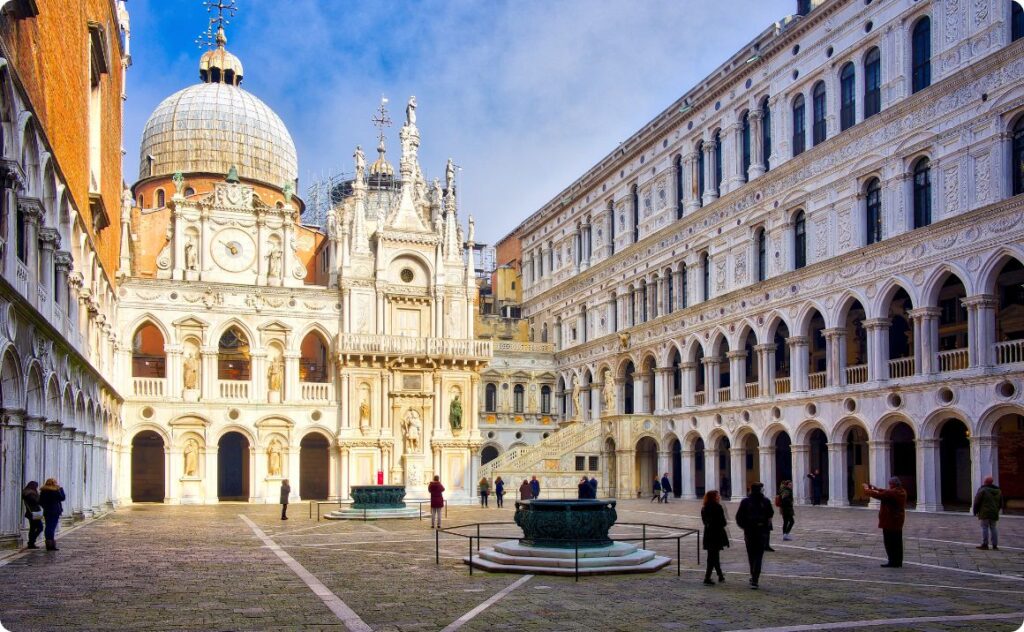
Doge’s Palace Venice skip-the-line ticket: quick access
Buy online. Choose your preferred time. Visit Venice’s Doge’s Palace, Bridge of Sighs, prisons and more.
You can cancel for free up to the day before your visit.
Interior of the Doge’s Palace Venice: frequently asked questions
The Doge’s Palace in Venice contains a complete compendium of the history, politics, art, and institutions of the Venetian Republic.
The Palazzo is made up of about a thousand rooms, not all of which can be visited.
A visit to the Palace takes at least a couple of hours, three if you want to visit it at a more leisurely pace.
Conclusions
This article on the interiors of the Doge’s Palace in Venice concludes here. You can take it with you as you walk through the wonderful rooms of the Palace, so that you have a summary of the works housed and the functions that the different rooms performed.
If you have any further questions or curiosities do not hesitate to write to me!
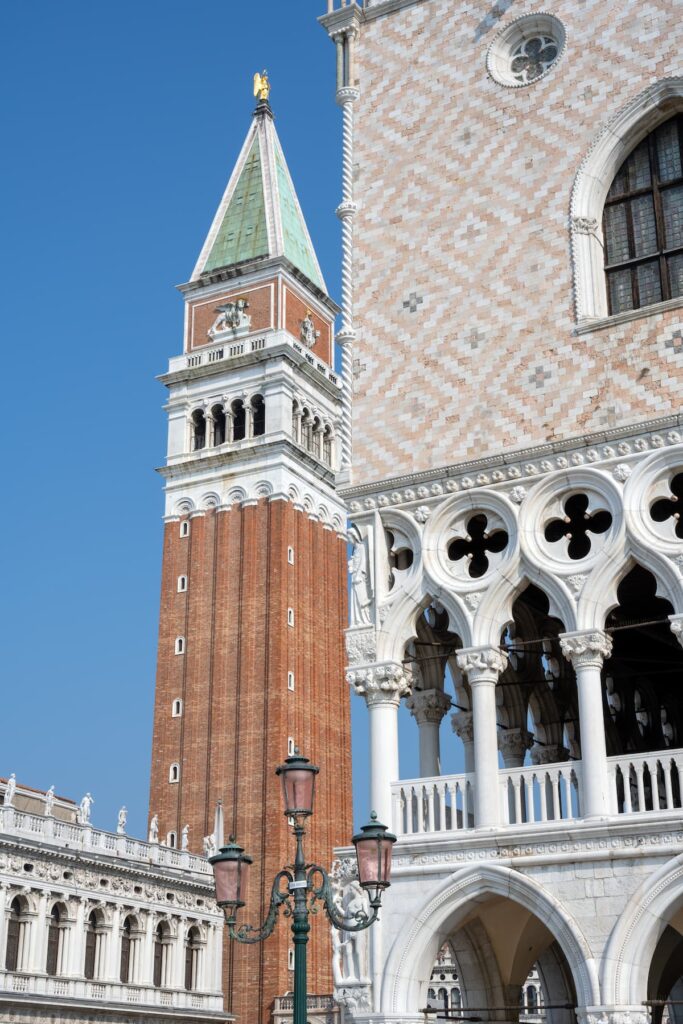
Doge’s Palace Venice skip-the-line ticket: quick access
Buy online. Choose your preferred time. Visit Venice’s Doge’s Palace, Bridge of Sighs, prisons and more.
You can cancel for free up to the day before your visit.
Photo credits
- Prigioni: Photo by Nishimoto Daikei via Flickr
- Sala dello Scudo: Photo by Alan Aplin via Flickr
- Liagò: Photo by Reading Tom via Flickr
- Quarantia Civil Vecchia: Photo by Nishimoto Daikei via Flickr
- Sala del Senato: Photo by Shay Tressa DeSimone via Flickr
- Sala del Collegio: Photo by Shay Tressa DeSimone via Flickr
- Armeria: Photo by Shay Tressa DeSimone via Flickr
- Piombi: Photo by Claudio e Lucia Images around the world via Flickr

